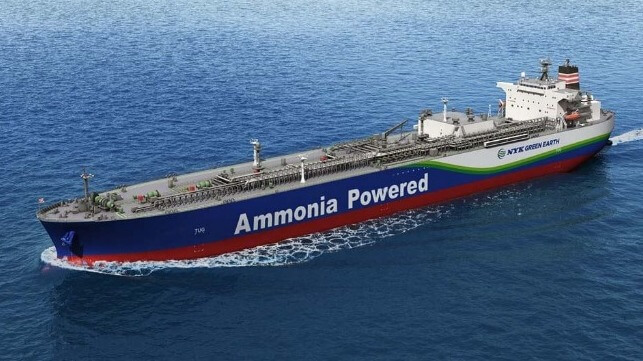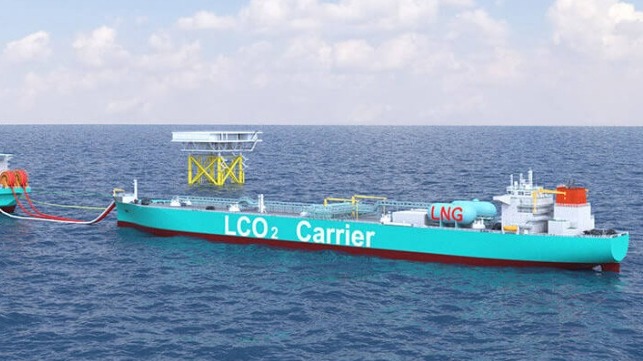Japanese Order First Mid-Sized Ammonia-Fueled Ammonia Carrier

A Japanese consortium of companies working on a project sponsored by the government to develop ammonia shipping reports it has reached the point where it can now begin to build one of the first ammonia-fueled ammonia carriers in the world. The group, which includes NYK, Japan Engine, IHI Power Systems, and Nihon Shipyard, reports it signed construction contacts last month for a vessel which they expect to complete by November 2026.
The new vessel is being reported as “the world’s first ammonia-fueled medium gas carrier.” It will have a transportation capacity of 40,000 cbm of ammonia fuel and be powered by an ammonia dual-fuel two-stroke engine produced by Japan Engine. The goal is to achieve a 95 percent combustion rate on the ammonia fuel mix. In addition, IHI will provide the auxiliary ammonia-fuel auxiliary engine with a mixed combustion rate of 80 percent or higher. The vessel will be built by Japan Marine United Corporation at its Ariake Shipyard.
The consortium was launched in October 2021 as part of a program sponsored by Japan’s New Energy and Industrial Technology Development Organization (NEDO) with ClassNK joining to provide the risk assessments. The effort developed a prototype that overcame the key challenges associated with ammonia and received an Approval in Principle in September 2022. After further research and development, they have agreed to proceed with the construction of the ship, which they believe will contribute to the practical application of ammonia-fueled ships.
They highlight key challenges including the need to manage the toxicity and reduce risk for the crew and the ship. The design they said must prevent leakage from the pipes and tanks. Also, because ammonia is a flame retardant, they have to achieve stable combustion. The vessel also has to treat the potential of nitrous oxide (N2O) emissions which may be generated during ammonia combustion and are a more potent greenhouse gas than CO2.
The effort has already reached key milestones including IHI Power Systems achieved the first stable combustion for ammonia fuel at an 80 percent co-firing rate in a four-stroke engine. The design of the vessel will optimize the hull for ammonia transport. NYK engineers have been consulting to provide proposals on the safety measures for the ship.
They expect that the project as one of the first for ammonia-fueled ammonia carriers will contribute to understanding and knowledge as well as help to shape the regulatory environment. They note that the International Maritime Organization is still studying potential rules for ammonia as there are no international rules in place today for ammonia as a fuel. They note that the consortium has already proposed draft safety requirements and expects to contribute to international rule-making.
The next steps in the project include detailed studies for the vessel’s construction. They will also produce an operating manual for the ship.
The Japanese effort is in addition to programs underway in South Korea. The three major shipyards have each recently begun accepting orders for large ammonia carriers. They anticipate that these vessels will transition to ammonia-fueled propulsion as the technology and regulatory environment is completed.
Japan highlights the critical nature of developing the ammonia value chain. They anticipate a strong demand for transportation capabilities as ammonia emerges as a fuel. They also anticipate that it will be used for co-firing of thermal power plants and as a hydrogen carrier.
Rising to the Challenges of CO2 Shipping

Somewhat paradoxically, CO2 will be required to help decarbonize the shipping industry, and that CO2 must often be shipped around the world. From ship design to containment systems, we must view these vessels as part of the wider supply chain says Sean McLaughlin, Strategy Consultant at design and engineering consultancy Houlder.
While CO2 has been transported by sea for nearly fifty years, we will soon see a fast-growing demand to move larger volumes of CO2 in order to support efforts to decarbonize shipping and heavy industry. Forecasts for growth in demand for CO2 shipping are largely based on the expanding network of sequestration routes for CO2 captured from industry.
There is also a potential new demand from within the maritime industry. Captured or biogenic CO2 is needed to produce some net-zero emission e-fuels – specifically e-methanol and e-methane (e-LNG). This will be sourced from a combination of carbon captured from land-based industry and from capture equipment onboard ships. In addition, there is an expectation that significant quantities of CO2 will be captured directly from the air.
Changing CO2 carrier designs
The growth in reuse opportunities is expected to give rise to new routes and potentially different CO2 carrier designs. Shipowners cannot rely on a repeat of previous designs that fail to recognise the number of variables for key areas such as cargo containment.
It is not just those who plan to build dedicated CO2 carriers that need to be aware of the challenges. As onboard carbon capture becomes more commonplace, almost every ocean-going ship type has the potential to become a CO2 carrier and will need to contain the captured carbon onboard.
CO2 purity
One of the key challenges when it comes to CO2 shipping is that not all CO2 is the same. CO2 purity is primarily dictated by the method of its capture and the source of the CO2 – for example exhaust gases or an industrial or chemical process.
It’s not just a percentage game, as the nature of the impurity is often as relevant as its quantity. The level and type of impurity will have implications for the sizing and type of the onboard containment, the liquefaction plant and it is even relevant to the sequestration processes. This will impact on both CAPEX and OPEX decisions.
Carbon capture technologiess
There are several types of carbon capture technology with a large number of companies developing equipment that can be installed onboard. Even though carbon capture itself is not a new activity, it has historically been done as part of an industrial process, and capturing CO2 from an exhaust gas stream has only been a focus for the last ten to fifteen years. The challenges of capture in a marine environment have only been tackled in more recent years. The shipping industry must engage with carbon capture technology providers if the challenge of moving this process onboard is to be overcome. It’s also of equal importance that the industry understands the challenges of the whole logistics chain if the opportunities of onboard capture and bulk LCO2 transport are to be grasped.
Misconceptions or misunderstandings could result in significant over-specification of storage tanks or liquefaction plants resulting in unnecessary CAPEX or constraints on the vessel's operations. There is also the potential of a ‘baked-in’ OPEX problem resulting from significant and potentially unnecessary increases in non-revenue earning cargo weight and energy consumption in the associated containment plant.
The macro view
Zooming out, we must also remember that it is not enough to simply capture CO2 – we must effectively sequester or reuse it to reduce greenhouse gas emissions. This requires alignment between the ship and onshore infrastructure. CO2 shipping (as a primary cargo or as a consequence of onboard capture) is a clear example of how we must view the ship as part of the whole logistics chain, rather than in isolation.
We cannot expect coordinated end-to-end CO2 supply chains to “just happen” either – proactive cross-industry collaboration is seen as vital. This was one of the key findings of the Houlder Navigator decarbonization whitepaper developed one year ago by interviewing shipowners who own or operate vessels in various segments.
Rising to the challenges of the decarbonization transition means embracing new paradigms and ways of operating, rather than the gradual evolution that shipping has previously been used to. Being bold, challenging assumptions and avoiding being stifled by traditional ways of working are all highly relevant when developing new CO2 supply chains and rising to the challenges of CO2 shipping. If we take this onboard, the nascent onboard capture and CO2 shipping sectors present exciting opportunities.
Sean McLaughlin is a strategy consultant with Houlder.
No comments:
Post a Comment